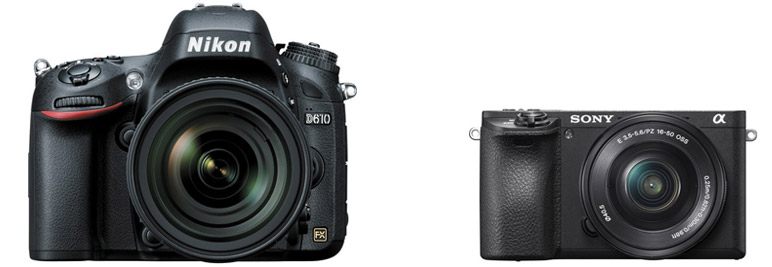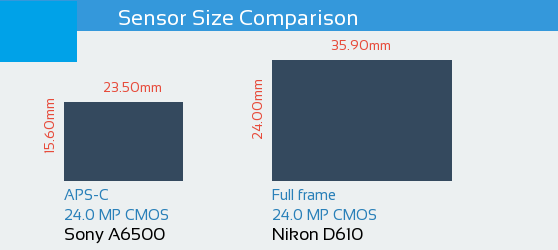Nikon D610 vs Sony A6500
: Let’s compare the Nikon D610 and the Sony Alpha A6500. Two digital cameras, the former being a semi-pro DSLR and the latter a semi-pro mirrorless camera. The Alpha A6500 features a 24.0MP APS-C sensor while the D610 features a 24.0MP Full frame sensor. Here’s a brief overview of the specifications before we go into more detail.
Sony A6500 vs Nikon D610 Specs

Nikon D610 vs Sony A6500 – Comparison
Specifications |
Nikon D610 |
Sony A6500 |
|---|---|---|
| Megapixels | 24.3 | 24.2 |
| Sensor Type | CMOS | CMOS |
| Sensor Format | Full Frame (FX) | APS-C |
| Crop Factor | None | 1.5x |
| AA Filter | None | Yes |
| Image Resolution | 6016 x 4016 | 6000 x 4000 |
| Body Image Stabilization | No | Yes – 5-Axis |
| Lens Mount | Nikon FX | Sony E |
| ISO | 100 – 6,400 | 100 – 25,600 |
| Expanded ISO | 50 – 25,600 | 51,200 |
| AF Points | 39 | 425 |
| Cross-type AF Points | 9 | 425 phase |
| Continuous Mode | 6fps | 11fps |
| LCD | 3.2″ – Fixed | 3.0″ – Articulating |
| LCD Resolution | 921,000 dots | 921,600 dots |
| Touchscreen | No | Yes |
| Focus Peaking | No | Yes |
| Top LCD Display | Yes | No |
| Viewfinder Type | Optical | EVF |
| Viewfinder Coverage | 100% | 100% |
| Viewfinder Magnification | 0.70x | 1.07x |
| Video Resolution | 1920×1080 (60/50/30/25/24p) | 3840×2160 (30/25/24p) |
| 1280×720 (60/50p) | 1920×1080 (120/100/60/50p) | |
| Microphone Jack | Yes | Yes |
| Headphone Jack | Yes | No |
| Memory Card Type | SD + SD | SD or MS Pro |
| Dual Card Slots | Yes | No |
| SD UHS Support | UHS-I | UHS-I |
| Fastest Shutter Speed | 1/4000 | 1/4000 |
| Slowest Shutter Speed | 30″ | 30″ |
| Bulb Mode | Yes | Yes |
| JPEG Buffer Size | 30 | 231 |
| RAW Buffer Size | 15 | 110 |
| Time Lapse | Yes | Yes |
| Built-in Flash | Yes | Yes |
| Max Flash Sync Speed | 1/200 | 1/160 |
| Startup Time | 0.3s | 1.3s |
| Built-in Wi-Fi | No | Yes |
| Built-in GPS | No | No |
| Built-in NFC | No | Yes |
| Bluetooth | No | No |
| USB Type | USB 2.0 | USB 2.0 |
| Environmentally Sealed | Yes | Yes |
| Battery Life (CIPA) | 900 shots | 350 shots |
| Battery Included | Yes (EN-EL15) | Yes (NP-FW50) |
| Weight | 30.0 oz (850g) | 16.0 oz (453g) |
| Size | 5.6 x 4.4 x 3.2″ | 4.7 x 2.6 x 2.1″ |
| Price | Amazon | Amazon |
| Release Date | 2013 | 2016 |
Nikon D610 vs Sony A6500 Common Features
| Built-in Flash | Yes vs Yes | Useful in low-light |
| External Flash Shoe | Yes vs Yes | Better for flash photography |
| Viewfinder | Yes (Electronic) vs Yes (Optical) | Better framing and control |
| RAW Support | Yes vs Yes | Better image quality |
| Face Detection Focus | Yes vs Yes | Useful for portraits |
| Max Resolution | 24 MP vs 24 MP | Bigger prints and more details |
| LCD Screen Size | 3″ vs 3.2″ | Large display |
| LCD Screen Resolution | 922k dots vs 921k dots | Higher resolution screens |
| Continuous Shooting | 11.0fps vs 6.0fps | Fast shooting speeds |
| Microphone Port | Yes vs Yes | High-quality audio recording option |
| Environmental Sealing | Yes vs Yes | Shoot at tough conditions |
| AE Bracketing | Yes vs Yes | Useful for tough lighting conditions and HDR |
Sony A6500 vs Nikon D610 Size Comparison
The Sony Alpha A6500’s body is 21mm narrower, 46mm shorter and 29mm thinner than Nikon D610. It is the smaller of the two cameras. Additionally, the Alpha A6500 weighs 397g less than the Nikon D610.

Nikon D610 vs Sony A6500 – Comparison
Since the Nikon D610 has a Full frame sensor and the Sony A6500 has a smaller APS-C sensor, Sony A6500’s lenses for a similar focal length and aperture are generally lighter and smaller than the Nikon D610 lenses.
Sony A6500 vs Nikon D610 Sensor Comparison
Both the Sony A6500 and the Nikon D610 have 24.0 MP resolution sensor. However, the Sony A6500’s sensor is an APS-C (23.5 x 15.6 mm ) and the Nikon D610’s sensor is a Full frame (35.9 x 24 mm ). Hence, Nikon’s larger sensor area with the same resolution provides better light collecting capacity for a given aperture compared to the Sony A6500.

Sony A6500 vs Nikon D610 Sensor Comparison
Nikon’s D610 has a 2.4x Larger sensor area than the Sony A6500. Larger sensors allow you more control over the depth of field and blurry background compared to the smaller sensor when shot in same focal length and aperture.
Why You Should Choose The Sony A6500
| Wireless Connection | Yes vs Optional | Better connectivity |
| Built-in Image Stabilization | Sensor-shift vs None | All the lenses are stabilized |
| Articulating Screen | Yes vs No | Flexible shooting positions |
| Touch Screen | Yes vs No | Easy control of camera functions |
| Max ISO | 25.600 vs 6.400 | 300% higher Max ISO |
| Number of Focus Points | 425 vs 39 | 386 more focus points |
| Continuous Shooting | 11.0fps vs 6.0fps | 5 fps faster |
| Weight | 453 g vs 850 g | 397 g lighter |
| Price | $1,398 vs $1,480 | $82 cheaper |
| Max Video Resolution | 3840 x 2160 vs 1920 x 1080 | Higher Resolution Video |
| NFC Connection | Yes vs No | Easy wireless connectivity with compatible devices |
| Smartphone_remote control | Yes vs No | Remote control your camera with a smartphone |
Advantages of the Sony A6500 Over Nikon D610
- Sensor Format – Full Frame is bigger than APS-C, which results in slightly less noise at higher ISO levels.
- AA Filter – The Nikon D610 has no AA filter.
- LCD – 3.2″ vs 3.0″.
- Top LCD Display – When shooting in semi-auto/manual modes, you can quickly preview all of your settings.
- Headphone Jack – Useful for previewing your audio quality straight out the camera.
- Dual Card Slots – More room for extra photos, or simply for backup.
- Max Flash Sync Speed – 1/200 vs 1/160.
- Battery Life – 900 shots vs 350 shots.
Video: Sony A6500 Hands-on Review
Why You Should Choose The Nikon D610
| LCD Screen Size | 3.2″ vs 3″ | 0.2 inches larger display |
| Battery Life | 900 shots vs 350 shots | 550 more frames with a single charge |
| Headphone Port | Yes vs No | better video control |
| Time-lapse Recording | Yes vs With optional app | creative shooting |
| Flash Coverage | 12.0m vs 6.0m | 6m longer range |
| Sensor Pixel Area | 35.66µm2 vs 15.28µm2 | 133% larger pixel area |
| Top LCD | Yes vs No | Help to view and change settings easily |
| Storage Slot | 2 vs 1 | Extra storage slot |
Advantages of the Nikon D610 Over the Sony A6500
- ISO – 51,200 vs 25,600. Higher maximum ISO sensitivity.
- AF Points – 425 vs 39.
- Continuous mode – 11fps vs 6fps. More is better for sports and wildlife since you have more chances of getting a tack sharp shot.
- LCD – It’s articulated.
- LCD Resolution – Higher resolution.
- Touchscreen Support
- Focus Peaking – Very useful for seeing if your subject is in focus (both photo and video).
- Viewfinder Magnification – Higher magnification.
- Video Resolution – 4K video available.
- JPEG Buffer Size – 231 vs 30.
- RAW Buffer Size – 110 vs 15.
- Built-in Wi-Fi
- Built-in NFC
- Weight – The Sony A6500 weighs 397g less.
- Size – The Sony A6500 is noticeably smaller.